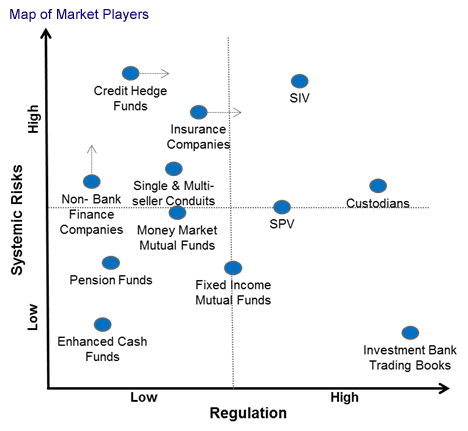Shadow Banking Products in Europe and North America: Different Seasonings for the Alphabet Soup
Abstract
Shadow banking remains a disquieting buzzword for regulators, who up to this point have not figured out how and when to regulate these entities. Presently, regulations acutely focus on “too big to fail” institutions, with broader scrutiny on other bank surrogates. This can result in a flight to shadow banking activities in order to secure liquidity that is imposed on firms by regulators, thus causing wrong way systemic risk.
Some parts of shadow banking are more or less key in today’s economy and finance, according to the report Shadow Banking Products in Europe and North America: Different Seasonings for the Alphabet Soup. Shadow banking regulations are not final and sometimes overly political, but market infrastructure and trends also partly dictate what is there to come for these products.
The term “alphabet soup” reflects exactly what these activities are: various products put under the same umbrella but that operate differently, independently, with a logic of their own, with different risk management implications, different technological needs, and different business evolution and opportunities. With varied market impact as well as potential regulatory impact, one cannot have only one offering across shadow banking products, but instead should pick and choose which products to invest in and how to tackle them in a tailored way.

“The diversity of shadow banking products and the even more diverse problems that emerge from regulations reinforce that market players that want to develop solutions in these areas should really pick and choose their opportunities,” says Joséphine de Chazournes, Senior Analyst with Celent’s Securities & Investments Group and coauthor of the report.
“Under distress or severe abstruse circumstances, risks taken by shadow banks can easily be transmitted to the banking sector through direct borrowing from the banking system and banking contingent liabilities, such as credit enhancements and liquidity lines,” says Medy Agami, Analyst with Celent’s Securities & Investments Group and coauthor of the report. “Regardless, regulators cannot completely get rid of shadow banking markets since they provide liquidity to virtually every sector of the economy.”
This report outlines the regulations that impact shadow banking products in Europe and the US. It explains how different products are used, and highlights the risk management and technology advancement opportunities that various products may represent in the coming years.
This 29-page report contains 8 figures and 6 tables.

